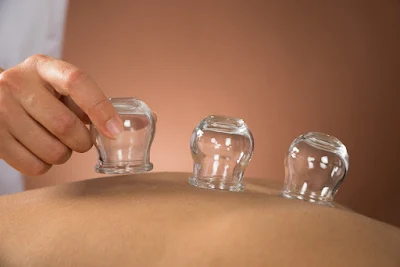 |
| Hijama Cupping Therapy |
In our modern, fast-paced world, stress, and ailments have become an all-too-common occurrence. But what if we could find solace and healing in an age-old practice? Enter "Hijama," an ancient cupping therapy that has stood the test of time and is now gaining popularity as a powerful alternative healing technique. In this blog post, we will explore the fascinating world of Hijama, its origins, benefits, and life hacks to incorporate this ancient healing practice into our busy lives for a healthier and happier existence.
1. The History and Origins of Hijama
Hijama, also known as cupping therapy, traces its roots back to ancient civilizations in Egypt, China, and the Middle East. The practice involves creating a vacuum inside small cups and placing them on the skin, creating suction. This technique is believed to promote blood circulation, detoxification, and energy flow throughout the body, aiming to restore balance and relieve various health issues.
2. The Benefits of Hijama
Hijama offers a plethora of benefits that contribute to overall well-being. Some of these include:
- Pain Relief: Hijama can alleviate various types of pain, such as back pain, muscle tension, and headaches, by promoting blood flow and releasing stagnant energy.
- Detoxification: The therapy stimulates the lymphatic system, aiding the body in removing toxins and impurities.
- Improved Circulation: By increasing blood circulation, Hijama supports better nutrient delivery to tissues and organs, enhancing their functionality.
- Stress Reduction: The relaxation induced by Hijama helps reduce stress levels and promote mental well-being.
3. Incorporating Hijama into Your Life
Now that we understand the benefits, it's time to explore practical ways to incorporate Hijama into our daily lives:
- Seek Professional Expertise: To experience the full benefits of Hijama, it is crucial to consult with a licensed and experienced practitioner who can tailor the therapy to your specific needs.
- Mindful Scheduling: Set aside dedicated time for your Hijama sessions. Whether it's once a month or bi-weekly, consistent treatments will yield more noticeable results.
- Create a Relaxing Environment: Prepare a calming space at home where you can relax before and after the session. Soft music, dim lighting, and aromatherapy can enhance the experience.
- Hydrate and Nourish: Stay hydrated before and after Hijama to support the body's detoxification process. Nourishing foods rich in nutrients will aid in faster recovery.
- Combine with Other Holistic Practices: Pairing Hijama with practices like yoga, meditation, or herbal remedies can enhance its effects and promote overall well-being.
Conclusion
In a world filled with modern medicines and technologies, it's reassuring to know that ancient healing practices like Hijama still hold tremendous value in promoting our health and vitality. By embracing this age-old wisdom and incorporating it into our lives, we can tap into a wealth of benefits that lead to a better, more balanced version of ourselves. Remember, as with any alternative therapy, it's essential to consult a healthcare professional before starting Hijama, but once you do, get ready to experience a revitalized you - mind, body, and soul.
 |
| Traditional Medicine |
ADVANTAGES OF TRADITIONAL MEDICINE
1. Holistic Approach: Traditional medicine often takes a holistic approach to healthcare, considering the interconnectedness of the body, mind, and spirit. It focuses on treating the root cause of an illness rather than merely addressing the symptoms.
2. Time-Tested Knowledge: Traditional medicine systems have been developed and refined over centuries, accumulating a vast body of knowledge and experience in diagnosing and treating various ailments.
3. Natural Remedies: Many traditional medicines use natural ingredients like herbs, plants, and minerals, which are generally considered safe and have fewer side effects compared to synthetic drugs.
4. Cultural Relevance: Traditional medicine is deeply rooted in the culture and history of specific communities, making it more relatable and acceptable to people in those regions.
5. Personalized Treatments: Practitioners of traditional medicine often tailor treatments to individual patients, considering their unique constitution, lifestyle, and health conditions.
6. Preventive Focus: Traditional medicine emphasizes preventive healthcare, encouraging healthy habits and lifestyle changes to avoid diseases before they manifest.
 |
| Alternate Medicine |
 |
| Therapeutic cupping |
ADVANTAGES OF ALTERNATIVE MEDICINE
1. Complementary to Conventional Medicine: Alternative medicine can work alongside conventional treatments, providing additional support and potentially reducing side effects.
2. Non-Invasive Techniques: Many alternative therapies, such as acupuncture and chiropractic care, are non-invasive, meaning they do not require surgical procedures or harsh interventions.
3. Individual Empowerment: Alternative medicine often encourages patients to take an active role in their healing process, promoting self-awareness and lifestyle changes.
4. Expanded Treatment Options: Alternative medicine offers a broader range of treatment options for patients who may not respond well to conventional treatments.
5. Focus on Well-being: Alternative medicine emphasizes overall well-being, addressing not only physical symptoms but also mental and emotional health.
6. Mind-Body Connection: Many alternative therapies recognize the connection between mental and physical health, aiming to restore balance in both areas.
ADVANTAGES OF THERAPEUTIC CUPPING
1. Pain Relief: Therapeutic cupping can provide effective relief from muscular pain, tension, and discomfort by improving blood flow and reducing inflammation.
2. Muscle Relaxation: The suction created by cupping helps relax tense muscles, making it beneficial for athletes and individuals with chronic muscle stiffness.
3. Detoxification: Cupping therapy stimulates the lymphatic system, aiding the body in eliminating toxins and waste products.
4. Improved Circulation: By enhancing blood circulation, cupping promotes better nutrient and oxygen delivery to tissues, supporting their healing and regeneration.
5. Stress Reduction: The relaxation induced during cupping sessions can reduce stress and anxiety, promoting a sense of well-being.
6. Versatility: Cupping therapy can be applied to various body parts, making it versatile in treating a wide range of conditions and ailments.
It's important to note that while traditional and alternative medicines have their advantages, they may not be suitable for all health conditions. Always consult with qualified healthcare professionals before incorporating any new treatment into your healthcare regimen.





Comments
Post a Comment
We would Love to Hear From You!